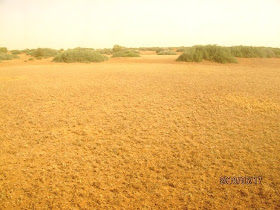The second and last day of our visit to Arak began with a visit to the Mighan Desert, about 30 km north east of the city. Leaving Amir Kabir hotel early in the morning, we were taken on a convoy of two busload of foreign as well as Iranian guests, prior to attending the 'World Day to Combat Desertification' ceremony.
Mighan Kavir or "Tozli Gol" desert is chosen as the venue and focus of Iran's observation to mark the World Day to Combat Desertification at the national level for this year. Located in the west of central zone of Iran, the desert has a total land area of about 50,000 hectares near Davoodabad district with a population of 650,000 people. It has a bowl-shaped structure with a number of seasonal rivers and streams. Its central parts are surrounded by sedimentary, metamorphic and igneous formations.
In the past decades, Mighan desert and its wetland has been threatened by a number of climatic and human factors including low rainfall, high wind, drought, landslide and flooding, mining, road and dam constructions, overgrazing and hunting of migratory birds. This prompted the local government to take several measures aimed at rehabilitation and restoration of the ecosystem and biodiversity of the Mighan desert and wetlands.
The national ceremony to mark the day was being held in the middle of the Mighan Kavir wetland. This year, the Day's slogan is "Enhancing Soils Anywhere, Enhances Life Everywhere."
The day's event began with several remarks from distinguished guests, experts and authorities on the subject of desertification throughout the country as well as an exhibition to promote awareness among the public to combat desertification and drought.
Unlike Iran and many other countries which are severely affected by issues of drought and desertification or land degradation, we in Brunei are very fortunate of not being associated with such problems as those countries with arid, semi-arid and sub-humid areas. Nonetheless, there are important lessons which we could derive and learn from the event, particularly on the value of soil biodiversity.
For example, under our feet lies a whole different world with a lifecycle of its own. A large and diverse body of the soil's living species determines the nature and quality of livelihoods and ecosystems above ground. Do we know that in some cases, there are up to five tonnes of animal life found in one hectare of soil? Do we know that in one teaspoon of soil may contain up to 6,000 different species and a billion bacteria?
These are but a few interesting environmental facts that I have just found out while following and observing the day and indeed help to enhance greater awareness to value soil biodiversity and indeed soil as a living system.
Wassalam.




















No comments:
Post a Comment